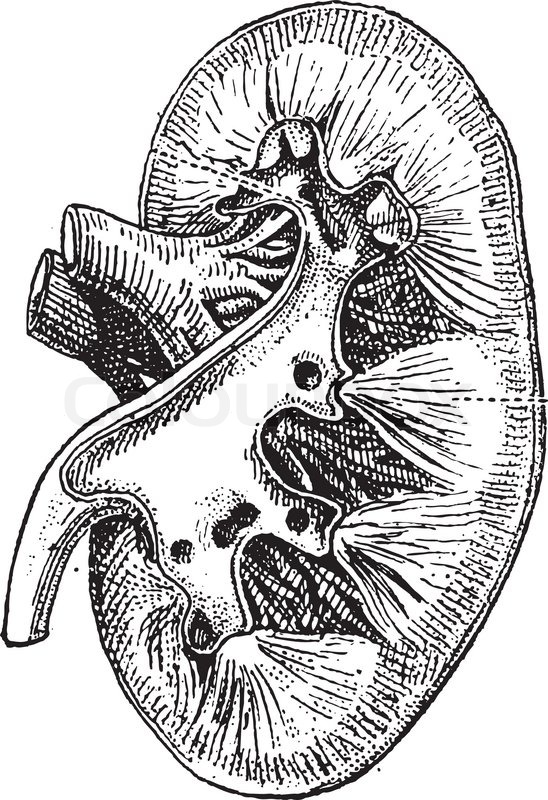


The Procedure
"The first successful organ transplant", December 23, 1954, Joseph E. Murray Papers 1919-2011
Operation Day
" Those of us on the surgical team began to understand what it felt like to be a pitcher in the World Series. The difference was that, unlike that pitcher, we were about to attempt something we had never done before."
-Joseph E. Murray, 2001, Surgery of the Soul: Reflections on a Curious Career
December 23rd, 1954, Peter Bent Brigham Hospital, Boston Massachusetts
8:15 a.m. ~ The procedure begins with two teams. Dr. Harrison operates on Ronald, the donor, and Dr. Murray prepares to operate on Richard, the recipient of the kidney.
9:50 a.m. ~ Dr. Harrison waits for Dr. Murray's signal to sever the blood supply from Ronald's kidney.
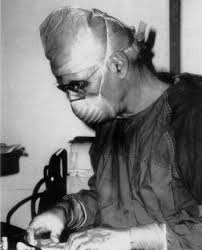
Joseph E. Murray operating,
Stanford University
"When I was completely prepared, I took a deep breath and gave Dr. Harrison the go-ahead to sever the blood supply from Ronald's left normal kidney. From that moment on, timing was critical. At all costs, the time between cutting off the blood supply to the donor organ and reestablishing it in the recipient (the 'ischemic time') had to be as short as possible."
~Joseph E. Murray, 2001,"Surgery of the Soul: Reflections on a Curious Career."
9:53 a.m. ~ Dr. Francis Moore carries the kidney into the operating room. They need to quickly establish blood flow into Richard.
"We could not let Richard's blood flow into his new kidney until we had attached his native vessels... For this reason, clamps had been placed on two of Richard's arteries supplying his kidney and his leg."
-Joseph E. Murray, 2001, Surgery of the Soul: Reflections on a Curious Career
10:10 a.m. ~ They begin attaching the kidney's renal artery to Richard's iliac artery.
10:40 a.m. ~ The attachment of the arteries is completed.
11:15 a.m. ~ They begin attaching the kidney's renal vein to Richard's iliac vein.
"Joining the donor renal vein to Richard's external iliac vein took a bit longer... Although I was well aware of the time ticking away throughout the procedure- everyone was- I could only continue to work carefully and systematically and, at all costs, efficiently. We would know soon enough whether I had succeeded."
-Joseph E. Murray, 2001, Surgery of the Soul: Reflections on a Curious Career
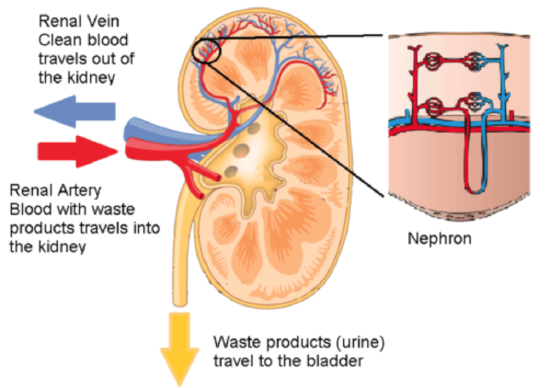
Diagram of a Kidney, February 9, 2020, Biology LibreTexts
12:37 p.m. ~ It has been an hour and twenty-two minutes with no blood flow to Richard's new kidney. The clamps are released and the surgeons watch the blood flow.
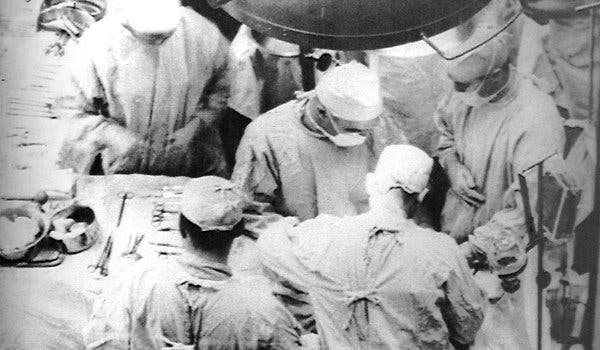
Dr. Murray operating, 1954, The New York Times
"Had we taken too long?...
We watched—some with fingers crossed, some saying silent prayers—as the transplanted kidney gradually turned pink and plumped up, engorged by Richard’s blood."
-Joseph E. Murray, The Fight For Life
12:47 p.m. ~ The team notes pulsation in Richard's foot. They now attach the urinary bladder to the ureter.
2:47 p.m. ~ Richard and Ronald wake slowly in the recovery room from anesthesia. The transplant has succeeded!
"Both Richard and Ronald recovered smoothly. Ronald’s single kidney was doing the job of two, and Richard’s new kidney was more than compensating for his two diseased ones."
-Joseph E. Murray, The Fight For Life
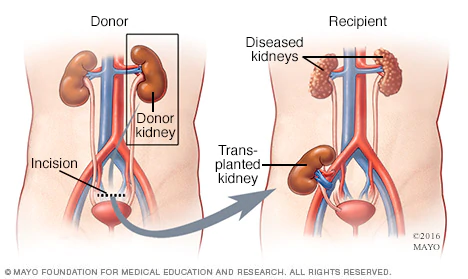
Diagram of transplanted kidney, 2016, Mayo Clinic

After the Procedure
"Since operation five weeks ago, Richard has done very well. The wounds healed rapidly, his transplant has functioned immediately and continously. The course of the future is unknown and the best method of future treatement is a matter of conjecture only. In my opinion, his future longevity depends entirely on his transplant as an 'all or none' phenomenon. Either the transplant will take or it will not. Therefore every possible and theoretical mode of protecting this transplant should be taken as soon as possible."
~Joseph E. Murray, January 25, 1955
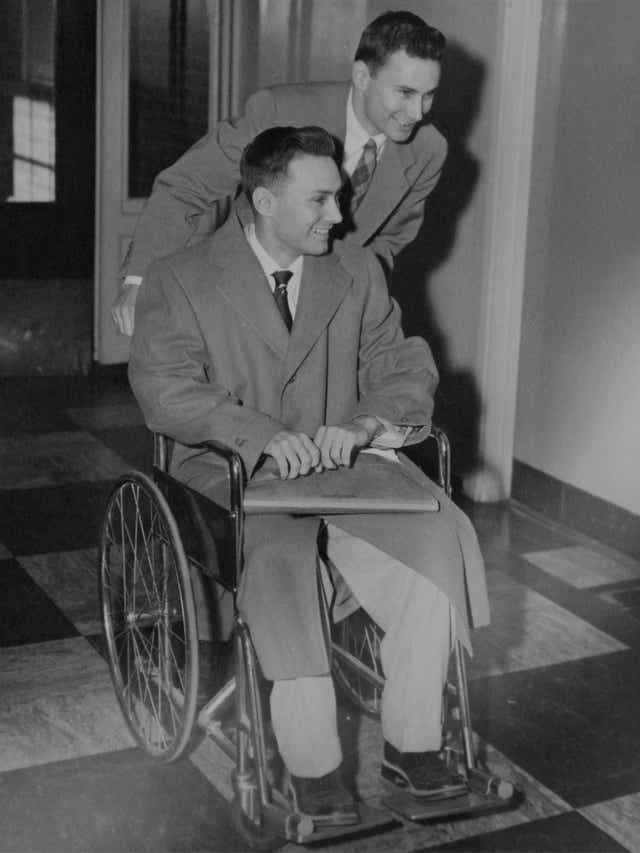
Herrick Twins leaving
the Peter Bent Brigham Hospital,
January 30, 1955, Green Bay Press Gazette
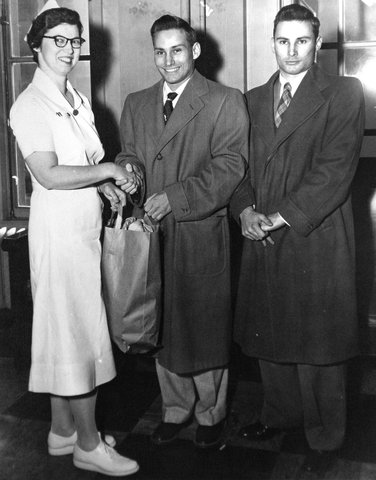
Herrick Twins with Nurse Clare, 1955,
Photo Provided by the Herrick Family
When both patients recovered, Merrill and Murray disagreed about what to do next. Murray wanted to remove both diseased kidneys immediately because he believed that leaving them would increase the risk of infection and possibly spread the disease. However, Merrill believed that Richard should keep one of his native kidneys to absorb harmful substances. With this disagreement, Murray went to Moore to discuss the situation and gain another perspective. The new kidney continued to support Richard, which changed Merrill's opinion. This led to Richard's left nephrectomy on March 29, 1955 and his right nephrectomy on June 20, 1955.
"To the patient, any operation is momentous."
~Joseph E. Murray